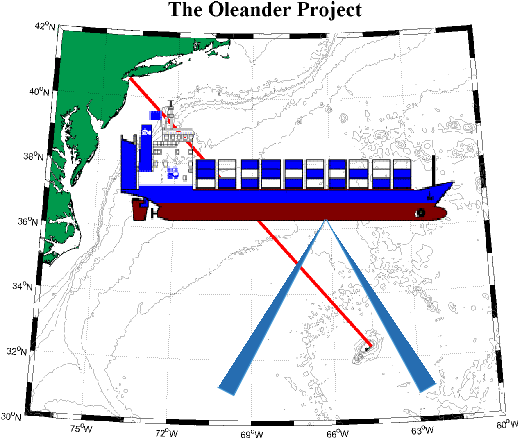



|
|
|
|
|
|
Charles N. Flagg E-mail: Charles.Flagg@sunysb.edu Marine Sciences Research Center Stony Brook University Stony Brook, NY 11794 Ruth Curry E-mail: Ruth.Curry@bios.edu Bermuda Institute for Ocean Sciences St.George's GE 01 Bermuda |
Thomas
R. Rossby
E-mail: trossby@gso.uri.edu Kathy Donohue E-mail: kdonohue@gso.uri.edu Sandy Fontana E-mail: sfontana@gso.uri.edu Graduate School of Occeanography University of Rhode Island Narragansett, RI 02882 |
 |
Introduction
The Oleander Project started in 1992 with the installation of a narrow-band 150kHz RD Instruments ADCP on Bermuda Container Line's container RO/RO ship, the MV Oleander. The current Oleander, built in Holland in 1990, is the second vessel of the same name and makes weekly round-trips between Elisabeth, New Jersey and Hamilton, Bermuda. The vessel is 388' long with a beam of 65', a loaded draft of about 18' and cruises at about 18kts. The interesting thing from an oceanographic point of view is the ship's frequent repeat transits through ecologically and climatically important northwest Atlantic regions including the continental shelf and slope, the slope sea, the Gulf Stream and the Sargasso. In 1990 Tom Rossby contacted the ship builders and persuaded them to include a coffer dam between holds two and three in the hope that we would be able to persuade the funding groups to support the ADCP operation. At the same time Rossby and Charles Flagg sent a successful proposal to NOAA's Atlantic Climate Change Program to support the installation of an ADCP and to run the system for a period of five years. Thus, the ADCP was installed during a routine dry-docking in September of 1992 and after getting over some teething problems, the instrument started producing data (Flagg et al, 1998). Data collection has proceeded since then with support from ONR for a year after the initial support from NOAA ended and for the past 8 years from NSF.
After ten years of operation, it became clear that the original narrow-band ADCP was slowly failing. We took the opportunity afforded by the necessary instrument replacement to completely overhaul the system by not only upgrading the ADCP to a new RD Instruments 75kHz Ocean Surveyor but also by modernizing the data collection and data handling. The 75 kHz Ocean Surveyor increased the range from a maximum of 350m in ideal conditions in the slope sea to over 750m over the entire cruise track. An important goal for these upgrades was to drastically shorten the time between data collection and dissemination. Instead of monthly trips to the ship to collect the data, an important aspect of the upgrade was the inclusion of a wireless internet connection ashore when the ship was tied up in Elisabeth, NJ. The wireless system was made possible through collaboration with the Bayonne High School, providentially located about 1.9 miles away across Newark Bay, Figure 1. A schematic of the new configuration is shown in Figure 2. We also had to develop a completely new system for continuing the autonomous data collection since RD Instruments' old DAS 2.48 had been replaced by the Windows-based VMDAS. This was accomplished through a Visual Basic program called AutoADCP for VMDAS that controls the configuration of the ADCP based upon the ship's location as well as providing a watchdog function. Since the Ocean Surveyor results in a different data format a completely new data processing system was also required. The development of this system over a period of years was mostly carried out by Eric Firing and Jules Hummon from the University of Hawaii with some local modifications for our own purposes. The ADCP data is archived in Codas3 format which is the defacto standard for shipboard ADCP data storage.Flagg, C. N., G. Schwartze, et al. (1998). "Operating an acoustic Doppler current profiler aboard a container vessel." Journal of Atmospheric and Oceanic Technology 15: 257-271.
Click here for a figure that shows the Oleander Project's study area and the current AutoADCP regions used to determine the OS-75's configuration.Acknowledgements
The long-term observational program that has
been carried out on the CMV Oleander owes an enormous debt of
gratitude to the Bermuda Container Lines as well as to the
forbearance of Captains Vrolyk, Van der Westeringh and Pye, and
the ship's engineers and crew.
Data Retrieval
This web page is intended to be the primary method for disseminating the ADCP data collected during the program. The data is concatenated into yearly Codas3 data blocks which can be accessed by clicking on the year listed below and filling out the form. As new data is collected it will be added to the current years' data blocks. The usual method of data extraction is by specifying a date window but it is also possible to specify a latitude/longitude window. Then specify the desired depth range and vertical averaging. Remember that the usual vertical binsize is 8 meters so nothing smaller than that will work. Also remember that the upper most bins start around 14 meters so specifying a shallower starting depth will produce nan's even if some of the specified bin contains usable data. The extracted data can be returned in either flat-ASCII format or as MATLAB.